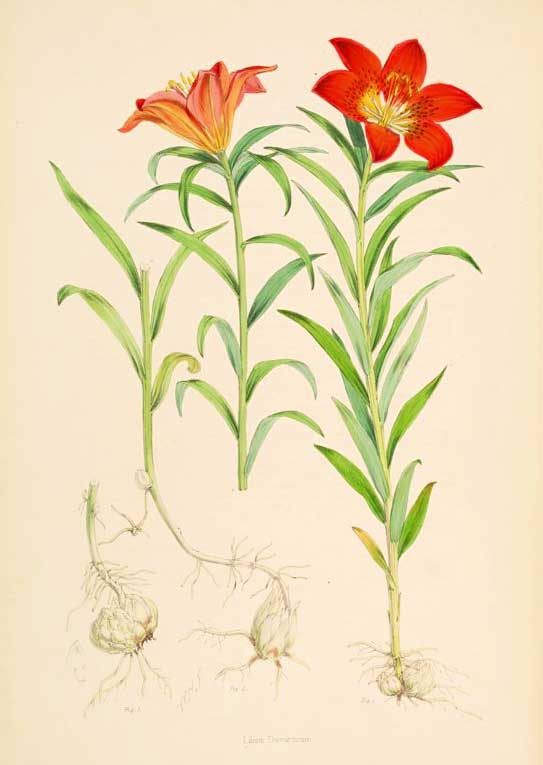
Lilium pensylvanicum (*)
Classification System: APG IV
Superregnum: Eukaryota
Regnum: Plantae
Cladus: Angiosperms
Cladus: Monocots
Ordo: Liliales
Familia: Liliaceae
Subfamilia: Lilioideae
Genus: Lilium
Sectio: L. sect. Sinomartagon
Species: Lilium pensylvanicum
Name
Lilium pensylvanicum Ker Gawl., 1805.
Synonyms
Homotypic
Lilium dauricum Ker Gawl., Bot. Mag. 30: t. 1210 (1809), nom. superfl.
Lilium bulbiferum subsp. dauricum Baker, Gard. Chron. 1871: 1034 (1871).
Lilium maculatum subsp. dauricum (Baker) H.Hara, J. Jap. Bot. 38: 249 (1963).
Lilium maculatum var. dauricum (Baker) Ohwi, Fl. Jap., ed. rev.: 1438 (1965).
Heterotypic
Lilium spectabile Link, Enum. Hort. Berol. Alt. 1: 321 (1821), nom. illeg.
Lilium catesbaei Kunth, Enum. Pl. 4: 264 (1843), nom. illeg.
Lilium formosum Lem., Ill. Hort. 12: t. 459 (1865).
Lilium dauricum var. tigrinum Regel, Gartenflora 21: 295 (1872).
Lilium citrinum G.F.Wilson, Notes Lilies: 71 (1873).
Lilium dahuricum Reuthe, Gartenflora 41: 476 (1891).
Lilium dauricum var. costatum Regel, Gartenflora 41: 476 (1891).
Lilium pseudodahuricum M.Fedoss. & S.Fedoss., Index Seminum (TU, Dorpatensis) 1899: 45 (1899).
Lilium dauricum var. alpinum Kuzen., Trudy Bot. Muz. 18: 80 (1920).
Lilium sachalinense Vrishcz, Novosti Sist. Vyssh. Rast. 1968: 48 (1968).
Lilium dauricum var. bihoroanum M.Furuya, Lily Yearb. N. Amer. Lily Soc. 62: 88 (2009), no Latin descr. and type.
Lilium dauricum var. furuyanum M.Furuya, Lily Yearb. N. Amer. Lily Soc. 62: 87 (2009), no Latin descr. and type.
Hybrids
L. × elegans – L. × scottiae
Distribution
Native distribution areas:
Continental: Asia-Temperate
Regional: Eastern Asia
Amur, Irkutsk, Japan, Kamchatka, Khabarovsk, Korea, Kuril Is., Manchuria, Mongolia, Sakhalin, Yakutskiya
Regional: Siberia
Krasnoyarsk, Primorye
Regional: Central Asia
Buryatiya
Regional: China
China North-Central, Chita, Inner Mongolia
References: Brummitt, R.K. 2001. TDWG – World Geographical Scheme for Recording Plant Distributions, 2nd Edition
References
Primary references
Ker Gawler, J.B. 1805. Botanical Magazine London 22: t. 872.
Additional references
Kozhevnikov, A.E., Kozhevnikov, Z.V., Kwak, M. & Lee, B.Y. (2019). Illustrated flora of the Primorsky Territory, Russian Far East: 1-1124. National institute of biological resources.
Links
Govaerts, R. et al. 2022. Lilium pensylvanicum in World Checklist of Selected Plant Families. The Board of Trustees of the Royal Botanic Gardens, Kew. Published online. Accessed: 2022 August 01. Reference page.
Hassler, M. 2022. Lilium pensylvanicum. World Plants: Synonymic Checklists of the Vascular Plants of the World In: Roskovh, Y., Abucay, L., Orrell, T., Nicolson, D., Bailly, N., Kirk, P., Bourgoin, T., DeWalt, R.E., Decock, W., De Wever, A., Nieukerken, E. van, Zarucchi, J. & Penev, L., eds. 2022. Species 2000 & ITIS Catalogue of Life. Published online. Accessed: 2022 August 02. Reference page.
Tropicos.org 2022. Lilium pensylvanicum. Missouri Botanical Garden. Published online. Accessed: 02 August 2022.
International Plant Names Index. 2022. Lilium pensylvanicum. Published online. Accessed: August 02 2022.
USDA, ARS, Germplasm Resources Information Network. Lilium pensylvanicum Ker Gawl. in the Germplasm Resources Information Network (GRIN), U.S. Department of Agriculture Agricultural Research Service. Accessed: 2014-06-18.
Lilium pensylvanicum Ker Gawl. – Taxon details on Integrated Taxonomic Information System (ITIS).
Lilium pensylvanicum – Taxon details on National Center for Biotechnology Information (NCBI).
EOL: Lilium pensylvanicum
Vernacular names
العربية: زنبق ذهبي
日本語: エゾスカシユリ
한국어: 산나리
svenska: Gullbandslilja
中文: 天香百合, 毛百合
中文(简体): 毛百合
Lilium pensylvanicum is an Asian plant species of the family Liliaceae. Sometimes called the Siberian lily, it is native to a cold climate and needs frost in the winter. It is found in the wild form in Siberia, the Russian Far East, Mongolia, northeast China, Korea and Hokkaidō.[1][2]
The Latin name is misleading due to an error by the botanist John Bellenden Ker.[3]
Description
Lilium pensylvanicum reaches a height of 30–70 centimetres (12–28 in) and has a width up to 25 cm (10 in). The stem is hard, smooth and straight, the leaves linear to lanceolate, 4–5 cm (1.6–2.0 in) long and 3–4 millimetres (0.12–0.16 in) wide. The plant flowers in June and July with one to six upright, dish-shaped flowers. The flower consists of six tepals curving backward from the center. The seeds mature from August to September. The bulb is roundish with a diameter of about 2 cm (0.79 in).
Distribution in Japan
Lilium pensylvanicum is abundant in the wild form in the Notsuke Peninsula. Near the city of Betsukai, during July, in the "gardens of the flock of gruyas" there may be seen many photographers looking for the best snapshots of the flowering of the ezosukashiyuri, as this species is known in Japanese. The city Koshimizu, on the island of Hokkaidō, is known as the city of the ezosukashiyuri flowers. In the Ainu language, the flowers are called masarorunpe and that is also the traditional Ainu oil lamp made from a large mussel shell and supported on a three-forked stick.[4][5]
Cultivation
Lilium pensylvanicum is very undemanding and is easily cultivated. It is sensitive only in relation to drought. Thus the plant is popular in European and American gardens.
References
"Lilium pensylvanicum Ker Gawl., Bot. Mag. 22: t. 872 (1805)". World Checklist of Selected Plant Families. Royal Botanic Gardens, Kew.
Flora of China, Vol. 24 Page 140 毛百合 mao bai he Lilium dauricum Ker Gawler, Bot. Mag. 30: t. 1210. 1809.
Ker Gawler, John Bellenden 1805. Botanical Magazine 22: plate 872 + 2 subsequent text pages description in Latin, commentary in English, full-page color illustration
アイヌ民族博物館(白老町) Ainu Museum in Japanese
"平成16年ふるさと切手「北海道遺産II」の発行 Japan Post". in Japanese
Retrieved from "http://en.wikipedia.org/"
All text is available under the terms of the GNU Free Documentation License

